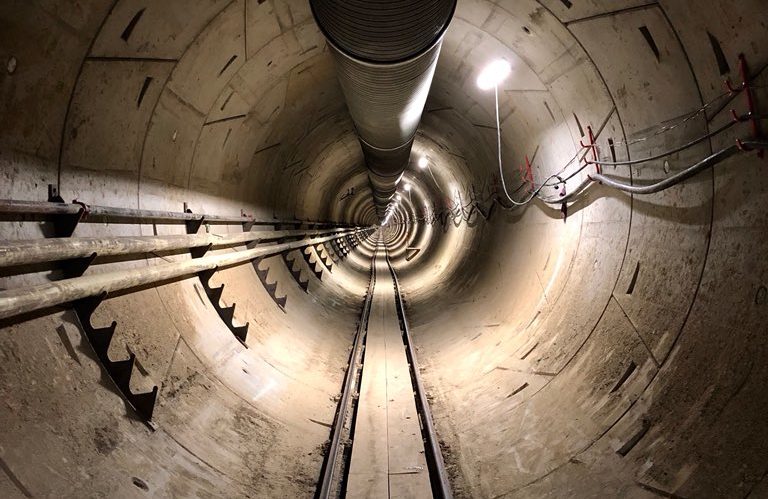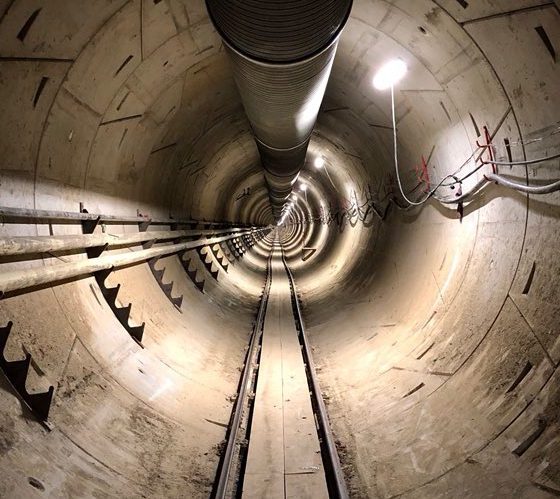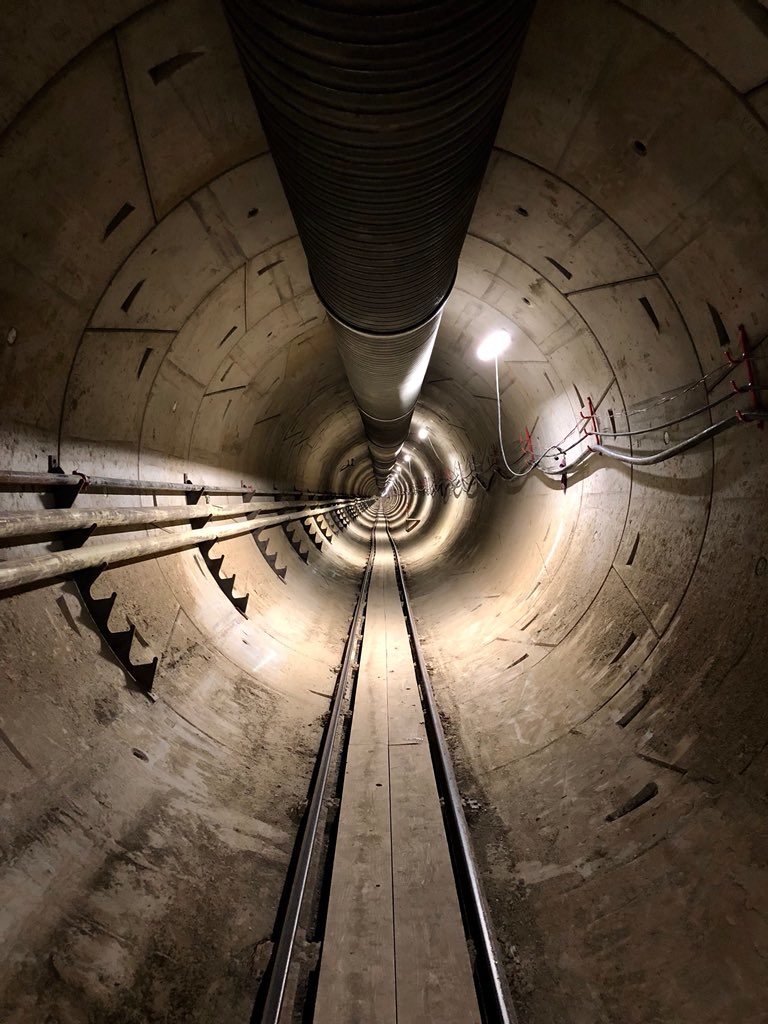

News
Elon Musk’s Boring Company shows off a very complete looking test tunnel in latest teaser image
The Boring Company recently shared an image of a section of its test tunnel under Hawthorne, CA, giving fans its clearest look yet.
With “rings on rings“, The Boring Company’s tunnels are anything but boring. In a request for tax exclusion submitted to the California Alternative Energy and Advanced Transportation Financing Authority last December, the tunneling startup stated that it intends to develop and use a new type of concrete for its tunnel linings.

The Boring Company’s tunnel under Hawthorne, CA. [Credit: The Boring Company/Twitter]
According to the tunneling startup’s filings last December, “advanced materials” would be used to manufacture the tunnels’ concrete walls. The concrete that will be used in the tunnels themselves will not be regular concrete, as the Boring Co. is designing the material to reach strengths in excess of 6,500 pounds per square inch. The concrete being developed by the company is also designed to be capable of fully setting in just 1-7 days, far quicker than the 28 days usually required by conventional concrete.
With this special formulation, The Boring Company expects to produce concrete tunnel linings that are incredibly dense, less permeable, and fully resistant to corrosion. A fully-automated carousel system to transport and set the concrete rings on the tunnels without human assistance is also being planned. With such a system in place, the Boring Co. is expecting to complete its tunneling projects faster.
While the Boring Company is arguably a hobby for the ultra-busy Elon Musk, and while the company courts fun headlines over its unique merchandise such as the Not-a-Flamethrower and the Boring Bricks (an Ice Blaster is said to be on the way), the startup does have the potential to be just as disruptive in the tunneling industry as Tesla is to the automotive market. During the company’s Information Session back in May, Elon Musk noted that the Boring Company is aiming to drill and lay tunnel walls simultaneously while transporting dirt using battery-powered locomotives. These locomotives will feature Tesla technology, with the machines being powered by two Model 3 electric motors.
The potential disruption of the Boring Company in the public transportation industry appears to have been one of the key factors behind the startup’s selection as the contractor of choice for Chicago’s planned downtown-O’Hare high-speed transport project. The bidding for the high-profile project involved several key infrastructure companies, including O’Hare Xpress LLC, a consortium comprised of participants from Antarctica Capital, Meridiam, First Transit, JLC Infrastructure, and UK-based Mott MacDonald, the design engineer for London’s Heathrow airport terminal. Despite the relative inexperience of the Boring Company compared to O’Hare Xpress LLC, the government of Chicago opted to award the project to the tunneling startup.
As the company prepares to break ground on its Chicago project, its tunnel in LA is set to offer free demo rides to the public soon, pending final regulatory approvals. If this recent video from the tunneling startup is any indication, these demo rides might end up a very colorful affair.
Colors! pic.twitter.com/qwsn7Myude
— The Boring Company (@boringcompany) July 13, 2018

News
Tesla FSD fleet is nearing 7 billion total miles, including 2.5 billion city miles
As can be seen on Tesla’s official FSD webpage, vehicles equipped with the system have now navigated over 6.99 billion miles.

Tesla’s Full Self-Driving (Supervised) fleet is closing in on almost 7 billion total miles driven, as per data posted by the company on its official FSD webpage.
These figures hint at the massive scale of data fueling Tesla’s rapid FSD improvements, which have been quite notable as of late.
FSD mileage milestones
As can be seen on Tesla’s official FSD webpage, vehicles equipped with the system have now navigated over 6.99 billion miles. Tesla owner and avid FSD tester Whole Mars Catalog also shared a screenshot indicating that from the nearly 7 billion miles traveled by the FSD fleet, more than 2.5 billion miles were driven inside cities.
City miles are particularly valuable for complex urban scenarios like unprotected turns, pedestrian interactions, and traffic lights. This is also the difference-maker for FSD, as only complex solutions, such as Waymo’s self-driving taxis, operate similarly on inner-city streets. And even then, incidents such as the San Francisco blackouts have proven challenging for sensor-rich vehicles like Waymos.
Tesla’s data edge
Tesla has a number of advantages in the autonomous vehicle sector, one of which is the size of its fleet and the number of vehicles training FSD on real-world roads. Tesla’s nearly 7 billion FSD miles then allow the company to roll out updates that make its vehicles behave like they are being driven by experienced drivers, even if they are operating on their own.
So notable are Tesla’s improvements to FSD that NVIDIA Director of Robotics Jim Fan, after experiencing FSD v14, noted that the system is the first AI that passes what he described as a “Physical Turing Test.”
“Despite knowing exactly how robot learning works, I still find it magical watching the steering wheel turn by itself. First it feels surreal, next it becomes routine. Then, like the smartphone, taking it away actively hurts. This is how humanity gets rewired and glued to god-like technologies,” Fan wrote in a post on X.
News
Tesla starts showing how FSD will change lives in Europe
Local officials tested the system on narrow country roads and were impressed by FSD’s smooth, human-like driving, with some calling the service a game-changer for everyday life in areas that are far from urban centers.

Tesla has launched Europe’s first public shuttle service using Full Self-Driving (Supervised) in the rural Eifelkreis Bitburg-Prüm region of Germany, demonstrating how the technology can restore independence and mobility for people who struggle with limited transport options.
Local officials tested the system on narrow country roads and were impressed by FSD’s smooth, human-like driving, with some calling the service a game-changer for everyday life in areas that are far from urban centers.
Officials see real impact on rural residents
Arzfeld Mayor Johannes Kuhl and District Administrator Andreas Kruppert personally tested the Tesla shuttle service. This allowed them to see just how well FSD navigated winding lanes and rural roads confidently. Kruppert said, “Autonomous driving sounds like science fiction to many, but we simply see here that it works totally well in rural regions too.” Kuhl, for his part, also noted that FSD “feels like a very experienced driver.”
The pilot complements the area’s “Citizen Bus” program, which provides on-demand rides for elderly residents who can no longer drive themselves. Tesla Europe shared a video of a demonstration of the service, highlighting how FSD gives people their freedom back, even in places where public transport is not as prevalent.
What the Ministry for Economic Affairs and Transport says
Rhineland-Palatinate’s Minister Daniela Schmitt supported the project, praising the collaboration that made this “first of its kind in Europe” possible. As per the ministry, the rural rollout for the service shows FSD’s potential beyond major cities, and it delivers tangible benefits like grocery runs, doctor visits, and social connections for isolated residents.
“Reliable and flexible mobility is especially vital in rural areas. With the launch of a shuttle service using self-driving vehicles (FSD supervised) by Tesla in the Eifelkreis Bitburg-Prüm, an innovative pilot project is now getting underway that complements local community bus services. It is the first project of its kind in Europe.
“The result is a real gain for rural mobility: greater accessibility, more flexibility and tangible benefits for everyday life. A strong signal for innovation, cooperation and future-oriented mobility beyond urban centers,” the ministry wrote in a LinkedIn post.
News
Tesla China quietly posts Robotaxi-related job listing
Tesla China is currently seeking a Low Voltage Electrical Engineer to work on circuit board design for the company’s autonomous vehicles.

Tesla has posted a new job listing in Shanghai explicitly tied to its Robotaxi program, fueling speculation that the company is preparing to launch its dedicated autonomous ride-hailing service in China.
As noted in the listing, Tesla China is currently seeking a Low Voltage Electrical Engineer to work on circuit board design for the company’s autonomous vehicles.
Robotaxi-specific role
The listing, which was shared on social media platform X by industry watcher @tslaming, suggested that Tesla China is looking to fill the role urgently. The job listing itself specifically mentions that the person hired for the role will be working on the Low Voltage Hardware team, which would design the circuit boards that would serve as the nervous system of the Robotaxi.
Key tasks for the role, as indicated in the job listing, include collaboration with PCB layout, firmware, mechanical, program management, and validation teams, among other responsibilities. The role is based in Shanghai.
China Robotaxi launch
China represents a massive potential market for robotaxis, with its dense urban centers and supportive policies in select cities. Tesla has limited permission to roll out FSD in the country, though despite this, its vehicles have been hailed as among the best in the market when it comes to autonomous features. So far, at least, it appears that China supports Tesla’s FSD and Robotaxi rollout.
This was hinted at in November, when Tesla brought the Cybercab to the 8th China International Import Expo (CIIE) in Shanghai, marking the first time that the autonomous two-seater was brought to the Asia-Pacific region. The vehicle, despite not having a release date in China, received a significant amount of interest among the event’s attendees.








